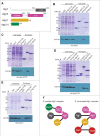Conserved and unique features of the fission yeast core Atg1 complex
- PMID: 28976798
- PMCID: PMC5788547
- DOI: 10.1080/15548627.2017.1382782
Conserved and unique features of the fission yeast core Atg1 complex
Abstract
Although the human ULK complex mediates phagophore initiation similar to the budding yeast Saccharomyces cerevisiae Atg1 complex, this complex contains ATG101 but not Atg29 and Atg31. Here, we analyzed the fission yeast Schizosaccharomyces pombe Atg1 complex, which has a subunit composition that resembles the human ULK complex. Our pairwise coprecipitation experiments showed that while the interactions between Atg1, Atg13, and Atg17 are conserved, Atg101 does not bind Atg17. Instead, Atg101 interacts with the HORMA domain of Atg13 and this enhances the stability of both proteins. We also found that S. pombe Atg17, the putative scaffold subunit, adopts a rod-shaped structure with no discernible curvature. Interestingly, S. pombe Atg17 binds S. cerevisiae Atg13, Atg29, and Atg31 in vitro, but it cannot complement the function of S. cerevisiae Atg17 in vivo. Furthermore, S. pombe Atg101 cannot substitute for the function of S. cerevisiae Atg29 and Atg31 in vivo. Collectively, our work generates new insights into the subunit organization and structural properties of an Atg101-containing Atg1/ULK complex.
Keywords: Atg1; Atg101; Atg17; Schizosaccharomyces pombe; ULK1; cross-linking coupled to mass spectrometry; electron microscopy (EM); protein-protein interaction.
Figures



References
-
- Mizushima N, Yoshimori T, Ohsumi Y. The role of Atg proteins in autophagosome formation. Annu Rev Cell Dev Biol. 2011;27:107-32. https://doi.org/10.1146/annurev-cellbio-092910-154005. PMID:21801009 - DOI - PubMed
-
- Reggiori F, Klionsky DJ. Autophagic processes in yeast: Mechanism, machinery and regulation. Genetics. 2013;194:341–61. https://doi.org/10.1534/genetics.112.149013. PMID:23733851 - DOI - PMC - PubMed
-
- Ragusa MJ, Stanley RE, Hurley JH. Architecture of the Atg17 complex as a scaffold for autophagosome biogenesis. Cell. 2012;151:1501–12. https://doi.org/10.1016/j.cell.2012.11.028. PMID:23219485 - DOI - PMC - PubMed
-
- Shintani T, Klionsky DJ. Autophagy in health and disease: A double-edged sword. Science. 2004;306:990–5. https://doi.org/10.1126/science.1099993. PMID:15528435 - DOI - PMC - PubMed
-
- Xie Z, Klionsky DJ. Autophagosome formation: Core machinery and adaptations. Nat Cell Biol. 2007;9:1102–9. https://doi.org/10.1038/ncb1007-1102. PMID:17909521 - DOI - PubMed
Publication types
MeSH terms
Substances
Grants and funding
LinkOut - more resources
Full Text Sources
Other Literature Sources
Molecular Biology Databases
Research Materials
